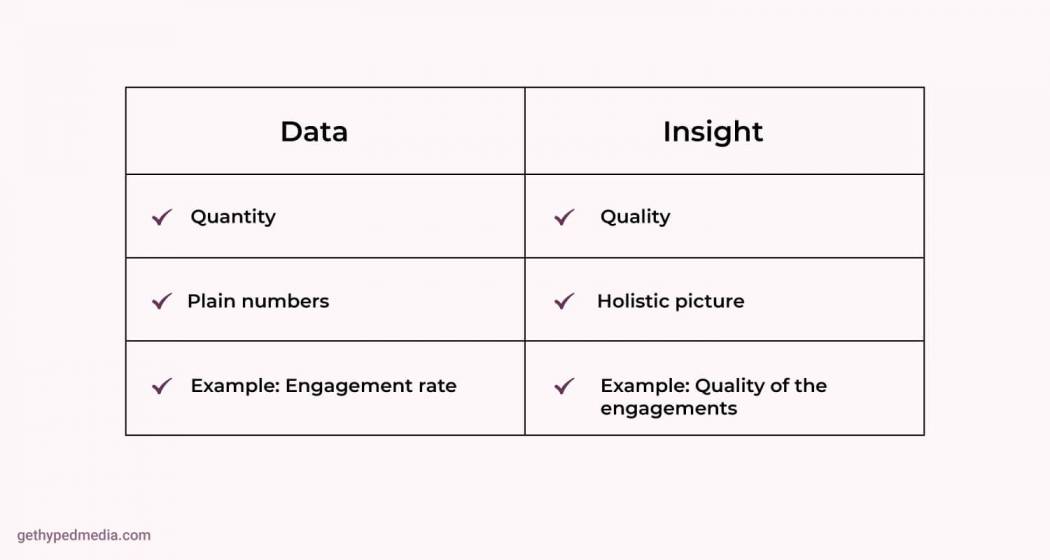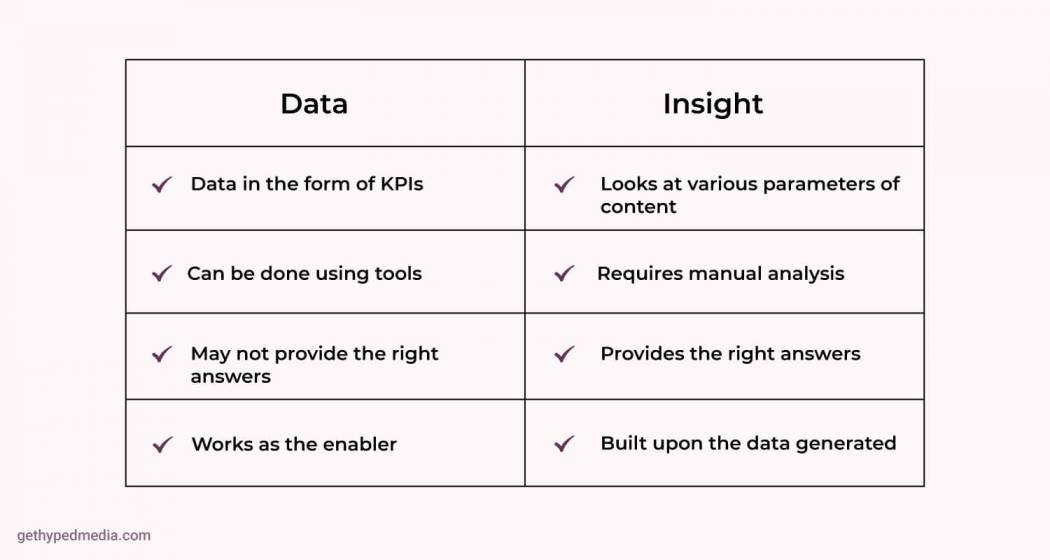There’s enough proof about the popularity of influencer marketing and platforms related to it. But what about the data vs insight debate specific to influencer marketing?
Well, you’ve likely used at least one of the numerous influencer marketing platforms that provide you with tons of data on influencers and the performance of your influencer campaigns too.
You probably have an idea of which KPIs you want to track to ensure that your campaign is progressing on target.
But in this quest for data-driven influencer marketing that can overly rely on KPIs, you might be forgetting about yet another essential campaign metric — insights.
And to help you understand which insights in influencer marketing are more important, we’ve put together this guide.
Table of Contents
Data vs. Insights: A Brief Overview
Before we dive into the data vs. insights debate when it comes to influencer marketing, it’s important to create a clear distinction between the two.
Data, which typically involves several KPIs, gives you a numerical metric based on which you can judge the progress of your influencer marketing campaigns.
Insights aren’t as simple as data, though.
In fact, insights are derived from understanding the data by reading between the lines, and that makes them extremely useful for making future marketing decisions.
In a nutshell, data is the enabler for insights. And insights, in turn, are actionable, which means that they can have a direct impact on optimizing your marketing strategy.
Insights take into account the entire holistic picture of your campaign performance while data or a certain KPI only looks at campaign performance in one area alone without accounting for the other campaign variables.
Data vs Insights in Influencer Marketing: A Detailed Look
Now that you’ve got a high-level idea of what data and insights are, let’s take a detailed look into each and compare them accordingly.
1. Quality vs Quantity

Looking at the KPIs will help you understand who brought in the most reach and engagement, and who drove the most leads or sales.
You’ve got hard data in the form of numbers and percentages to quantify the success of your campaign when you leverage data.
However, this is the extent to which data can help you understand your marketing campaign. It helps you look at the quantitative figures, and not much beyond that. In essence, you wouldn’t have the slightest idea about the qualitative aspects of your influencer marketing campaign if you only looked at the data.
And that’s precisely where insights can help.
Insights give you the holistic picture of your marketing campaign’s performance to understand its true impact — beyond only the numbers.
For example, instead of judging performance just on the number of engagements generated or the number of sign ups in your influencer marketing campaign, look at the various qualitative aspects of the campaign through insights.
These include things like comments sentiment, the quality of the leads, and the average revenue brought in by each sale.
This information doesn’t come from the KPIs. Instead, it requires more analysis by diving into the details of each audience conversation that’s happening as part of your campaign.
It’s these qualitative insights that can help inform your future decisions related to your marketing campaigns — usually much better than the data alone can.
2. Looking at the Bigger Picture
Simple data in the form of KPIs provides a look at your campaign’s performance through a keyhole instead of displaying the entire big picture.
Using KPIs, you can identify trends to figure out which influencers have managed to deliver a better performance than the others in select areas.
KPI data is obviously very useful as it gives you a detailed understanding of what’s going on in your influencer campaign and lets you compare one influencer’s performance to another.
However, KPIs have shortcomings when it comes to the total scope of your campaign analysis.
You want to manually review all of your influencer-generated content and go beyond what the KPIs show you to identify other trends that would get overlooked if you only looked at the data.
For example, the KPIs could show you that certain influencers are driving better results than the rest. But unless you do the manual work yourself and look into the reasons behind their specific success, you won’t know why their performance was better.
Were they a better fit for your brand because their content came across as more authentic or because they used storytelling in their messaging?
Reading through comments on the influencer’s posts and observing the conversations that are happening usually provides the answers to these questions.
These insights are crucial as they can shape your future influencer marketing decisions like choosing the right niche of influencers for your campaigns or deciding which influencers that you’ve worked with have the potential to become your brand ambassadors.
3. Analysis of Content

Data in the form of KPIs and other related metrics can only show you how a particular post by your influencers has performed.
For instance, data can tell you the number of impressions, engagements, link clicks, etc. All of these metrics give you some insight into which influencer’s content performed better than the rest.
However, numbers won’t help you decipher the entire truth.
For all you know, the influencers you picked may not be the right influencers for your brand. Alternatively, maybe some of your influencers created content that struck a chord with their target audience.
And that’s where it becomes essential to understand which aspects of the content led that particular influencer to outperform the others.
This is where insights can help.
You should manually analyze all the content and conversations created by your influencers to identify emerging patterns and establish a connection between the insights and performance.
The data in the form of KPIs aids in generating the insights, thus paving the way for better future campaign planning.
4. Assistance with Future Campaigns
Insights are also important when it comes to understanding how your current influencer marketing campaign’s strategy performed.
Without understanding what went right or wrong in the current campaign, you won’t be in a position to optimize performance of future campaigns.
However, when you’re armed with data and insights, you can get a detailed, holistic picture of your campaign’s true performance. Based on this analysis, you can determine which part of your strategy was successful and which parts need to be adjusted.
This approach of consistent observation of the insights and optimization of campaign strategy will improve your results over time and drive the highest ROI leading to business growth.
Important Examples to Settle the Data vs Insights Debate
Now that you have a good idea of how influencer marketing data and insights can help you grow your business, let’s take a look at a few examples to get a better understanding of their differences.
Example 1
Data:
Influencer X generated 10,434 engagements, and Influencer Y generated 5,676 total engagements. As a result, Influencer X generated the highest engagement, with an engagement rate of 7.85%!
Insight:
Now, when you analyze the data, you’d typically think that influencer X drove more engagements, and as a result, was the better influencer among the two.
However, insights can help you identify which influencer delivered a higher quality of engagements. This, in turn, can aid in understanding which influencer actually did a better job at engaging the target audience.
This is done by manually reading through the comments on each influencer’s post to identify which of the posts created more valuable conversations. By doing this, you’ll figure out which influencer is better for your future campaigns.
Valuable conversations are questions about the brand or the products. Questions like “Does it come in blue?” or “How did you feel after using it for a week?” are valuable because they demonstrate the audience’s interest in the products being promoted.
Alternatively, comments that don’t add much value are one-word comments or emojis. But the engagement data counts each comment the same so without insights the value of the comments is unknown.
The qualitative analysis of Insights trumps the quantitative analysis of the data.
Example 2:
Data:
On Instagram Stories, Influencer W generated 54 link clicks, Influencer X generated 132 link clicks, Influencer Y generated 445 link clicks, and Influencer Z generated 612 link clicks. Influencers Y and Z generated the highest link clicks and the lowest cost-per-click.
Insight:
By analyzing the data, you can figure out that Influencer Z was obviously the most successful at driving link clicks followed by Influencer Y and Influencer W. This almost confirms that Influencer Z might be the best suited for your brand.
But is that true?
You want some insights to really find out.
By analyzing the content, you could figure out the reasons why Influencer Z was able to generate the most number of link clicks.
In this particular case, it could be because Influencer Z clearly conveyed their experience of using your product. On the contrary, Influencer X only chose to promote the various features of your product and didn’t get as many people interested in it due to the same reason.
With this insight in mind, you could design your future influencer partnerships to instruct the influencers to develop content accordingly and generate greater engagement and traffic.
Final Thoughts
Influencer marketing is a great way to grow your business by building brand awareness, driving lead generation, and increasing sales.
However, if you want to leverage it to its full potential, you want to understand that data and insights are two very important, yet different, factors of your campaigns.
While data gives you quantitative figures based on which you can judge progress, insights help you look at the qualitative campaign aspects. This complete view can play a major role in informing your future campaign decisions.
That said, it doesn’t mean that data isn’t all that useful. In fact, insights are based on the data that you gather.
However, true insights can require an experienced eye and that’s where influencer agencies like Get Hyped can help. Get in touch with us and we can help you determine the insights from your last campaign together.



